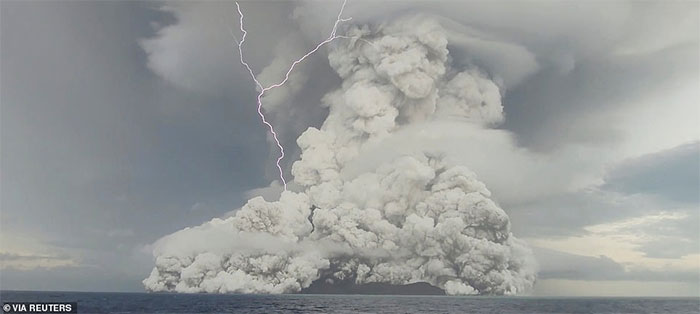The massive underwater volcano off the coast of Tonga erupted last month, releasing a record amount of ash into the atmosphere and leading to an unprecedented lightning event.
According to the global lightning detection network GLD360 operated by Vaisala, the eruption generated nearly 590,000 lightning strikes, unlike any event recorded before.
Meteorologist Chis Vagasky from Vaisala stated that hundreds of thousands of lightning strikes nearly covered the entire Tonga archipelago.

Lightning strikes in the volcanic eruption area. (Photo: Reuters).
He said: “I can’t imagine the situation the people on the islands must have experienced with a gigantic ash cloud, a tsunami that submerged everything they owned, and lightning striking from the clouds to the ground everywhere. They must have felt like it was the end of the world.”
Based on GLD360 data, Reuters created an animation depicting the increase in lightning strikes from January 13 to January 15.
On January 13, an explosion on the ground triggered a series of lightning strikes that continued until January 14.
Then, on January 15, the underwater volcano Hunga Tonga-Hunga Ha’apai “woke up” and caused a “wave” of nearly 400,000 lightning strikes within just six hours.
In total, there were nearly 590,000 lightning strikes over three days, significantly surpassing the previous record event, the eruption of Anak Krakatau in Indonesia in 2018.
Chis Vagasky noted that during the Anak Krakatau eruption in December 2018, they detected about 340,000 lightning strikes over the course of a week. Therefore, detecting nearly 400,000 strikes in just a few hours is extraordinary.
According to GLD360 data, approximately 56% of the lightning strikes observed in the skies over Tonga hit land or the ocean, including 1,300 strikes on the main island of Tongatapu. The remaining 44% occurred within the ash cloud or between clouds.
The seawater surrounding the eruption may also have played a role in the lightning storm. When lava comes into contact with water, it shatters into smaller pieces, increasing the number of particles available for collisions that create charged particles.
However, there are still questions about why volcanic lightning occurs, particularly at the level of particle interactions.
Vagasky reported that scientists are investigating the reasons behind the intensity of the Hunga Tonga eruption, including the scale of the explosion, seismic activity, pressure, tsunamis, and the amount of lightning produced.
According to a recent study, the event on January 15 was one of the most powerful eruptions ever recorded.
Scientists from the National Aeronautics and Space Administration (NASA) stated that the Tonga volcano’s eruption had an explosive yield equivalent to 5 million to 30 million tons of TNT.
Previously, the eruption of Mount St. Helens in Washington State, USA, in 1980 had a strength equivalent to about 24 million tons of TNT.
Hunga Tonga-Hunga Ha’apai, an underwater volcano in the South Pacific, ejected debris up to 40 kilometers into the atmosphere.
This 7.4 magnitude earthquake triggered a tsunami that devastated the Tonga archipelago. In addition to recovering from the volcanic disaster and tsunami, Tonga is also dealing with the COVID-19 pandemic.


















































